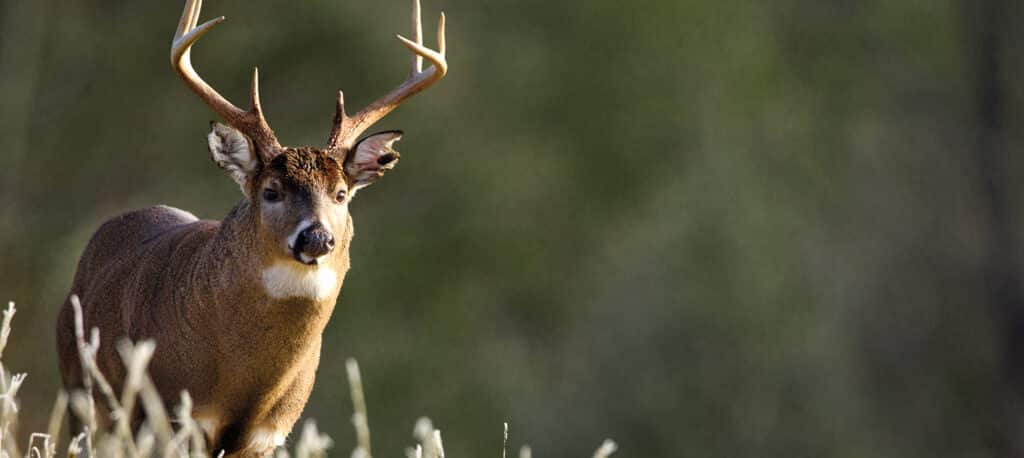
This article is featured in the Spring 2024 issue of Texas LAND magazine. Click here to find out more.
CWD, formally known as Chronic Wasting Disease, is a hot topic of conversation for wildlife agency officials, research scientists, landowners, wildlife managers, hunters and conservation-minded wildlife enthusiasts. The fatal disease affects members of the Cervidae family, which includes white-tailed deer, mule deer and elk.
According to the U.S. Geological Survey, CWD has been detected in 32 U.S. states and four Canadian provinces in free-ranging cervids and/or commercial captive cervid facilities. The first case of CWD in Texas was discovered in 2012 in free-ranging mule deer in the Hueco Mountains of far West Texas. Since then, it has been found in 28 counties in Texas.
I sat down with Dr. David “Dave” Hewitt, the Leroy G. Denman, Jr. Endowed Executive Director of Wildlife Research of the Caesar Kleberg Wildlife Research Institute at Texas A&M University-Kingsville and Professor in the Department of Rangeland and Wildlife Sciences. Hewitt is one of the most respected and knowledgeable deer experts in Texas.
1. What is CWD and where did it come from?
DH: Chronic Wasting Disease is from the same family of progressive, fatal neurological diseases as Bovine Spongiform Encephalopathy (BSE) or Mad Cow Disease in cattle, Scrapie in sheep and Creutzfeldt-Jakob disease in humans.
In these diseases, prions, naturally occurring proteins in the various mammals’ bodies, become malformed in a way that makes it difficult for the body to break down. The malformed proteins spur the malformation of other prions that then accumulate in the nervous system and disrupt normal physiological processes.
CWD was first observed in 1967 in captive deer at a research facility in Colorado. In 1981, the first infected wild animal, an elk from Rocky Mountain National Park, was diagnosed.
While CWD doesn’t completely obliterate herds, it can reduce populations and impact overall herd health. Because of factors that we don’t completely understand but appear to be related to soil types, environment and deer populations, the disease establishes itself at different rates. For instance, in two game management units in Colorado near where the disease was first detected, prevalence in adult bucks is 8 percent, whereas in several game management units in northeastern Colorado, prevalence in adult bucks is 33 percent.
2. How is it spread?
DH: That is a question that researchers are trying to answer definitively, but it appears there may be multiple sources of exposure. Prions are found in saliva, mucus and semen as well as feces and urine indicating that the disease can be passed directly from animal to animal.
Also, the prions don’t break down in the environment, so they persist. They can remain in the soil long after the carcass or waste from a diseased animal has decomposed. They also can be found at lick branches, rubs and other places of social interaction.
The impact of these various transmission routes is amplified when animals are confined. The idea that the closer animals are held in proximity the more likely it is that a disease will be passed from animal to animal is infectious animal disease principle 101.
3. What makes it so hard to manage?
DH: In addition to the prions remaining active in the environment for a long time, the disease incubates over a long period. Animals can be infected and shedding prions for months to years before showing acute symptoms.
In the early phases, symptoms are almost imperceptible. By the time animals begin showing distinctive symptoms such as extreme weight loss, drooling, standing in an abnormally wide stance because of impaired balance, and drinking an unusually high amount of water they are days to weeks from death.
Also, CWD affects animals within a whole family instead of a single species, so in areas where white-tailed deer and mule deer overlap, they can infect one another. In Texas, we also have exotics. Elk and sika deer are susceptible, while fallow deer don’t seem to be. The verdict is still out on Axis deer.
Until recently, there were no tests for CWD that could be performed on live animals, which for obvious reasons limited its usefulness to the captive deer breeding industry. Now, live tests exist, although they are not recognized by the federal government for regulatory purposes.
On the regulatory side of the equation, two agencies—the Texas Parks and Wildlife Department and the Texas Animal Health Commission—share jurisdiction over managing the disease. TPWD has responsibility for wild native deer and some aspects of captive deer. Because exotics are classified as livestock under Texas law, they fall under the Texas Animal Health Commission as do some aspects of captive deer breeding.
From a social and economic standpoint, people are accustomed to freely moving deer, particularly pen-raised deer, and deer carcasses across Texas. It is difficult to get people to look past the immediate sacrifices and inconveniences and invest in a future where CWD does not threaten all the benefits we get from deer and deer hunting.
Because CWD’s initial impact isn’t dramatic, it’s tempting for people to ignore it or lose interest. Unlike anthrax or blue tongue that flares up and burns out, CWD, if left unchecked, is a disease that will play out over decades and could permanently change the landscape of Texas.
4. What strategies have been implemented so far to contain CWD?
DH: Right now, our best strategy for minimizing CWD’s long-term impacts is to keep it from spreading to areas where it is not currently found. The best way to slow the disease’s spread is not moving infected deer or deer parts.
For captive deer that means not moving and releasing live animals from CWD positive areas to CWD-free areas. With the advent of live testing, deer breeders are required to test every live animal leaving their facilities before they are shipped. They are also required to test every deer that dies in their herds.
Hunters in CWD-positive zones are required to test every deer they harvest by submitting samples at a TPWD testing station. In addition, the brain and spinal cord must be disposed of in the CWD zone where the deer was harvested in a manner that keeps the prions out of the habitat. For instance, the remains may be put in a local community landfill. (Check the Texas Parks and Wildlife Department website https://tpwd.texas.gov/huntwild/wild/diseases/cwd/hunters/ for current regulations for processing and transporting deer parts from a CWD zone.)
Finally, there is an ongoing discussion about requiring all captive-raised deer that are released to be visibly identified with a permanent ear tag. The ear tag would make it possible to easily identify and track deer in the event their facility of origin later tested positive for CWD. It also would allow neighboring landowners to recognize introduced deer that escape the intended release site.
Proponents of the idea say this provision is already in the law and is not being enforced. Opponents of the proposal maintain the law makes permanent identification optional and places an undue and unnecessary burden on the industry.
The ultimate goal of reducing movement of infected deer and infected deer parts seems straightforward, but political, economic and social forces have come into play. As with most conservation challenges, nothing is ever simple
5. Why does CWD matter to Texans?
DH: Under our current model, hunters and anglers provide the nation’s largest source of conservation funding. They contribute to state-level conservation through national excise taxes on firearms and other equipment that are apportioned back to TPWD and by purchasing Texas hunting and fishing licenses which directly fund TPWD.
While the money is generated by game animals, birds and fish, the conservation funding benefits all wildlife species.
Hunting’s economic benefit goes beyond excise taxes and hunting license sales. In December 2023, Texas A&M’s Department of Rangeland, Wildlife and Fisheries Management released a report that estimated white-tailed deer hunters generated an estimated $4.6 billion in economic output. The same report calculated landowners supporting white-tailed deer hunting generated an estimated $5 billion in economic output.
That money circulates through the state’s economy and is particularly crucial to rural communities. In many instances, white-tailed deer hunting is the single largest income-stream on a ranch. Not only does the money fund private conservation, but it helps the landowner keep the ranch intact.
Intact ranches are home to the state’s environmental infrastructure that sequesters carbon, provides food and fiber, and produces clean air, water and wildlife habitat as well as many more benefits for all Texans. Without those lifegiving ecosystem services, Texas and Texans cannot survive.
For more information on CWD, check out the following online resources:
Texas Parks and Wildlife Department

